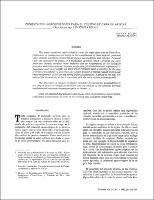Zonificación agroecológica para el cultivo de caña de azúcar (Saccharum spp.) en Costa Rica
Alternative title
Agroecological zones for sugar cane (Saccharum spp.) in Costa Rica.
Résumé
This paper establishes agro-ecological zones for sugar cane crop in Costa Rica. Definitions of zoning units are based on the combination of three indexes: potential yield, climatic conditions needed for saccharose accumulation, and soil class. Potential yield tsus calculated by means of a production function which correlates the most important climatic variables (solar radiation and air temperature) to the biological processes which determine net biomass production (photosynthesis and respiration) A frequential analysis of rainfall was also used; it expresses water availability for the crop in terms of probability of occurence of a certain amount of rainfall related to potential evapotranspiration (ETP) for the period under consideration. A period of ten days was selected for the analysis, as this is consistent with the water reserve in average soils.
The discussion of climatic conditions necessary for saccharose accumulation in the crop is based on rainfall probabilities and the analysis of the variation between rnaximum and minimum temperature prior to harvest. st.
Units are classified and placed in decreasing order of probability of good yields, to facilitate interpretation for users of the resulting agro-ecological zoning map.
Delegation
Sede Central
Éditeur
Instituto Interamericano de Cooperación para la Agricultura (IICA)
Is part of
Turrialba; Vol. 33, no. 2
Status
openAccess
Collections
- Turrialba [2688]


